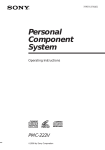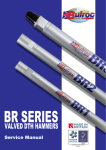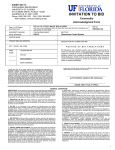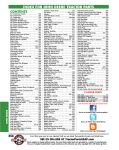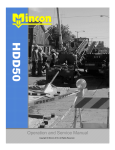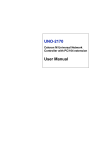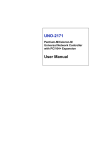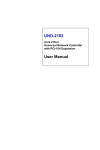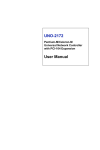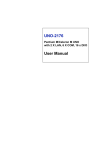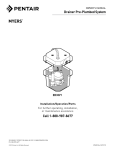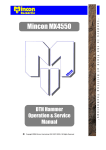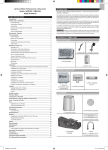Download Service Manual - Hardrock HDDP
Transcript
Hardrock Directional Drilling ® TABLE OF CONTENTS Table of Contents ...............................................................................2 1 Introduction ................................................................................3 2 Installation and Operation.........................................................4 2.1 Safety........................................................................................................................ 4 2.2 Set up of HDD50 Hammer and Sonde.................................................................. 4 2.2.1 2.2.2 2.2.3 2.3 Setup and Operation of Support Station ........................................................... 11 2.3.1 2.3.2 2.3.3 2.3.4 2.3.5 2.3.6 2.3.7 2.3.8 2.4 4 Set up of Support Station ...............................................................................4 Equipment Inspection Prior to Compressor Ignition .................................14 Pressure Regulator Adjustment ...................................................................15 Oiler Adjustment .......................................................................................... 16 Water Pump Adjustment and Operation ..................................................... 17 Commissioning of Hammer.........................................................................18 Lubrication ...................................................................................................19 Operation of Hammer .................................................................................. 20 Servicing ................................................................................................................ 21 2.4.1 2.4.2 2.4.3 2.4.4 2.4.5 2.4.6 2.4.7 3 Storage ............................................................................................................4 Setup of Sonde................................................................................................ 4 Installation of Bit ........................................................................................... 9 General .........................................................................................................21 Opening Chuck and Backhead....................................................................21 Dismantling Hammer to Change Drill Bit.................................................. 21 Disassembly for Full Servicing of Hammer ...............................................22 Inspection .....................................................................................................22 Checking Wear Limits .................................................................................23 Reassembly ...................................................................................................23 Appendix ................................................................................... 24 3.1 HDD50 exploded view and Parts List ................................................................. 24 3.2 HDD50 Hammer Service Log.............................................................................. 25 Warranty ................................................................................... 27 “Leaders in the Field of Drilling Technology” Page 2 of 27 1 Introduction This document covers the HDD50 Horizontal Directional Drilling System. The system consists of the following: HDD50 Horizontal DTH Hammer Support Station Compressor Water supply The basic setup is shown below. Support Pack Horizontal Directional Drill with HDD50 DTH Hammer Rock Drill Oil Injection Water injection Compressor to Drill adapter Compressor 900scfm/350spsi Water Truck Dust Control Sonde Cooling 2-4 Gal/Min The Installation and Operation section will deal with setup of the system and basic operation. Following that we will deal with disassembly and servicing. When dealing with the HDD50 in the service section we will separate it into two parts: Firstly the Down-the-Hole hammer component that makes drilling possible and secondly the Sonde housing component that makes steering possible. “Leaders in the Field of Drilling Technology” Page 3 of 27 2 Installation and Operation 2.1 Safety Be sure to work safely at all times. Wear protective clothing and safety equipment and observe all safety regulations as prescribed by your employer, Government, or the site on which you work. Do not wear loose clothing that may get caught in rotating parts and cause serious personal injury. Remember that a “Horizontal Down-the-Hole” percussive hammer emits noise and you should therefore take every precaution to safeguard your hearing against damage by using proper ear protectors. Use eye protection at all times. Rock chips and dust which may be discharged from the face of the bit or bore hole at high velocities and can cause severe injury. Hammers can be heavy – Always use proper and approved lifting equipment and take every precaution to safeguard yourself against injury. Keep hands clear at all times – Beware of getting fingers trapped between the chuck and bit and do not use hands or feet to clear the top of the borehole at any time. Other safety advice is given throughout this document which you are advised to read. 2.2 Set up of HDD50 Hammer and Sonde 2.2.1 Storage If you intend to store the HDD50 Hammer we recommend that ½ pint ( ¼ litre) of good quality rock drill oil be poured into the hammer to protect it. To do this the hammer section should be unscrewed from the Bent Sub and then the oil should be poured into the top of the hammer and let flow down into the piston chamber of the hammer to coat the parts and protect them from rust and corrosion. Once completed the bent sub and the Sonde Housing can be reinstalled. Ensure that the thread protector and chuck cap are fitted to keep debris out and to prevent oil leakage. Store the hammer horizontally in a clean dry place. 2.2.2 Setup of Sonde When the HDD50 is supplied it will contain the necessary parts for the successful installation of a commercial Sonde. The two main types of Sonde are dealt with in this manual: DCI Sonde and Sub Sight. “Leaders in the Field of Drilling Technology” Page 4 of 27 2.2.2.1 Installation of DCI Sonde The following series of picture will detail the installation of a DCI Sonde into the HDD50. The same procedure should be used for servicing or changing the sonde at a later date. STEP 1 STEP 2 Unscrew and remove Sonde Housing Backhead from the Sonde Housing Sleeve Insert and screw the retrieval bar into the Sonde Carriage retrieval cap and pull out the complete Sonde Carriage assembly. Step 3 Step 4 Unscrew and remove the Sonde Carriage Locating Cap, Springs and the DCI Adapter from the Sonde Carriage (Opposite end to the Sonde Carriage retrieval cap) Loosen and remove the DCI Adaptor Locating cap from the DCI Adaptor. Correct end has locating dimple. “Leaders in the Field of Drilling Technology” Page 5 of 27 Step 5 Step 6 Insert and push the DCI Sonde into the DCI Adaptor Step 7 Push the Sonde in the rest of the way and screw the DCI Adaptor Locating Cap in and tighten snugly with a wrench. Fit the DCI Adaptor Locating cap onto the DCI Sonde ensuring the Locating cap’s intrical key is seated correctly in the Sonde Keyway. Step 8 Step 9 Insert first spring into Insert the DCI Adaptor into the Sonde into the Sonde Carriage Carriage. Step 10 Insert the second spring in to the Sonde Carriage. “Leaders in the Field of Drilling Technology” Page 6 of 27 Step 11 Step 12 Align the Sonde Carriage Locaing Cap Groove with the DCI Adaptor Locking Dimple and push the cap on so that the hex socket of the Carriage Locaing Cap fits over the DCI Adaptor and then screw the Carriage Locking Cap in place Push the Sonde carriage into the Sonde Housing Sleeve with the Sonde Carriage Locating cap entering first. Step 14 Step 13 Screw the Retrieval bar into the Sonde Carriage and push forward until it stops. Turn gently until you feel the Sonde Carriage go forward and the Sonde Carriage Locking Cap groove seats over the Sonde Carriage Locating pin (See Step 14 for details of the pin). Step 15 Above picture shows the Sonde Carriage Locating Pin. The pin is in the Bent Sub set so that the Sonde will be aligned correctly in the twelve O’clock position. Insert and screw the Sonde Housing Backhead in place. “Leaders in the Field of Drilling Technology” Page 7 of 27 2.2.2.2 Installation of Sub-Sight Sonde The procedure for installing a Sub-Sight Sonde is the same as the DCI Sonde except Step 3 through Step 7 are replaced with the following: Step 1 Step 2 Above picture shows the end of the All screws to be inserted Sub Sight Sonde that will receive should have the threads coated the Sub Sight Locating adaptor. with a thread lock compound. Step 4 Step 5 Fit the second half of the Sub Sight Fit the top section of the Sub adaptor to the Sonde and tighten. Sight locating assembly and Then fit the assembly locking tighten. screw as shown above. Step 3 Fit the first half of the Sub Sight adaptor to the Sonde and tighten. Step 6 Unscrew the other end off the Subsight and replace with the Adaptor end cap shown above. Once completed the Sonde assembly can be installed from Step 8 above. “Leaders in the Field of Drilling Technology” Page 8 of 27 2.2.3 Installation of Bit The following sequence of instructions is used to correctly fit the bit in the correct orientation for drilling. Step 1 Step 2 Unscrew and remove the Chuck from the Hammer. Remove Bit Retaining Ring from the Chuck and screw the Chuck back in place. Step 3 Insert the bit into the Chuck so that the Bent Sub wear carbides are aligned in a straight line with the three bit wear carbides as illustrated above. “Leaders in the Field of Drilling Technology” Page 9 of 27 Step 4 Step 5 Unscrew the Chuck and Bit from the hammer making sure that the bit does not come out of the Chuck. Insert the Bit Retaining Rings back into the Chuck as shown above making sure that the Bit does not come out of the Chuck. Step 6 Push the Chuck forward to secure the Bit Retaining Ring in place against the rear splines. Screw the Chuck, Bit and Bit Retaining Rings in place. “Leaders in the Field of Drilling Technology” Page 10 of 27 Setup and Operation of Support Station Prior to operation the Support Station must be setup to ensure that correct and safe operation of the equipment is carried out. CAUTION – For safe working conditions during operation of the equipment it is essential to have received the appropriate training prior to starting up the equipment. Set up of Support Station Step 1: Unpack Support Station and check to make sure all components are present. Support Pack 30’ Air Hose Water Hose TRI Light Controller 2 Whip Checks 20’ Air Hose 2 Boss fittings are also included to adapt Support Station to most satisfactory air supplies. Caution: Rear handle is not to be used as a lifting device during unpacking or field operations. “Leaders in the Field of Drilling Technology” Page 11 of 27 Step 2 Step 3 Step 4 Support Station comes delivered with whip checks in place on both the air intake and discharge lines. Enlarge loop on the other end of the whip check on the air intake valve end and loop over air hose and release. Connect air hose to Support Station air intake valve. Ensure all connections are tightened properly. When completed pull whip checks back so that they are as shown above. Above picture shows air inlet side of support station. Step 5 Step 6 Step 7 Connect air hose to the compressor in the same manner. Connect other air hose to Support Station discharge line and to Drill. Connect TRI Light controller connections to electric valve. Before Operation, check level of oil in the water pump with dip stick shown above. Top off with approved crankcase oil as necessary. “Leaders in the Field of Drilling Technology” Page 12 of 27 Tank Fill Cap #1Vent Valve Step 8 CAUTION: Always follow these instructions when filling tank with rock drill oil. 1. Turn compressor off and shut valve off at compressor. 2. Turn electric valve off make sure you see a red light on the Tri-Lite Controller and Red or Yellow indicator on the top of valve is pointing perpendicular to valve body. 3. Open vent valve (Labelled #1 Vent Valve above) on far right side of front panel slowly, relieving air pressure inside of tank to atmospheric air pressure. 4. After air has bled out of tank, use hammer to hit four inch hammer fitting on top of tank counter clockwise to loosen, and then take off by hand. 5. Fill oil to top of tank, but not past fitting in the middle of the neck. 6. Refit Oil tank cap and tighten using a hammer. CAUTION: Always make sure 4” cap is tight on tank and vent valve is closed before starting compressor. “Leaders in the Field of Drilling Technology” Page 13 of 27 Equipment Inspection Prior to Compressor Ignition CAUTION: The following walk around check should be carried out prior to starting the compressor. Step Specific Equipment Required State 11 Hose connecting Drill to Support Station RED Air flow arrow goes to Drill. Hose connected to outlet valve. 22 Hose connecting compressor to Support Station Connected at electric inlet valve. 33 Inlet and Outlet Valve Connections Wing nuts tightened using hammer turning clockwise. 44 Inlet and outlet valves on Support Station Whip Checks Connected correctly as described in above sections. 55 Hose to compressor connection Wing nuts tightened using hammer turning clockwise. 66 Hose to compressor connection Whip Check Connected correctly as described in above sections. 77 Hose to Drill connection Wing nuts tightened using hammer turning clockwise. 88 Hose to Drill connection Whip Check Connected correctly as described in above sections. 99 4” Wing Nut on top of Rock Drill Oil Tank Tightened using hammer turning clockwise. 110 Rock Drill Oil Tank Vent Valve Close valve in the “12 o clock” or vertical position 111 Main Air Discharge valve (2” Valve to Drill) Open (Parallel to Valve Body) 112 Power Connections for Tri-Lite Controller Connected to 12V Battery – Black to NEGATIVE (-) and Red to POSITIVE (+) 113 Tri-Lite Controller Valve Operation Operating correctly – Red light means air off (Valve closed) Green light air on (Valve Open) 114 Tri-Lite Controller Valve Red light – air off (Valve closed) prior to starting compressor Complaint () “Leaders in the Field of Drilling Technology” Page 14 of 27 Pressure Regulator Adjustment On a new support station system, the pressure regulator needs to be set at 75 PSI. To adjust the pressure after the walk around inspection and the compressor is operational, turn the Air Discharge Valve (Valve to Drill) off. Turn electric valve on (Green light on) this will pressurize the system. Adjust the regulator clockwise to turn pressure up and counter clockwise to reduce pressure. Set pressure gauge to 75 PSI. After adjustment turn electric valve off (red light) and turn Air Discharge valve on. “Leaders in the Field of Drilling Technology” Page 15 of 27 Oiler Adjustment CAUTION: At the end of the days drilling, turn the valves off or you will be wasting oil. The oiler will continue to oil whether compressor is on or off. It is recommended on a new system, until the operator is familiar with the system, that after each rod is drilled, ¼ cup or two ounces of rock drill oil should be poured in each rod, especially if a new hammer is being commissioned. The amount of oil dispersed is dependent on where the needle valve is set. The Oiler valve is located on the front control panel. Turning the valve counter clockwise provides more oil and clockwise reduces oil flow. A good starting point is to close the valve fully and then turn one revolution counter clockwise. Oiler valve one and 2 (valve 1 to right of oiler knob, valve 2 left of vent) must be open for proper operation. During drilling the two valves should be on, and then turn valves off after drilling is complete each day. “Leaders in the Field of Drilling Technology” Page 16 of 27 Water Pump Adjustment and Operation: Always prime water hose before connecting cam lock to the pump. It is essential to have the water tank above the support station to maintain sufficient head pressure for the pump to operate. The water pump is powered by an air operated motor coupled to the water pump. The amount of water being introduced into the drilling operation is controlled using the valve on the top right of the control panel. The amount of water required to maintain a clean hole will be dependent on drilling conditions. Approximately 3-4 gallons per minute will suffice, however in softer rock conditions more water may be required and significantly harder rock conditions will require less. Once the optimal water injection is set the water will turn off when the operator turn off the main air supply to the drill and conversely will turn back on when the main air supply is re-pressurized. It is best to adjust the water while drilling as conditions can change throughout the entire bore hole. “Leaders in the Field of Drilling Technology” Page 17 of 27 Caution: Never turn the water pump on with the main discharge valve (2” Ball Valve to drill) on the support station closed. The water should always have a path out through the drill string. Always use clean water. Bentonite should not be used as it will clog the hammer requiring a complete overhaul to return the hammer to an operable condition. A good mixture of polymer and Con-Det is acceptable if drilling in clay. Check the in line filter on the pump periodically for debris. In colder conditions antifreeze the pump and drain the water hose and clean and empty the inline filter to protect from freezing while not operating the drill. 2.2.4 Commissioning of Hammer Coat the drill bit shank and the hammer threads with grease for protection and easier dismantling. Prior to use, lubricate the hammer with ½ pint ( ¼ litre) of rock drill oil as described above. Fit the hammer to the drilling rig ensuring no debris or dirt enters the hammer from the site, dirty tubes or from unclean air lines. Make sure that the coupling threads from the drill are of the same specification to that of the hammer and they are in good condition. Run the hammer at half the air flow for a few minutes to allow the oil to flow through and for internal components to settle in. “Leaders in the Field of Drilling Technology” Page 18 of 27 2.2.5 Lubrication It is vital for DTH hammers to receive a constant supply of proper rock drill oil to protect the internal components and to provide a good air seal between the piston and the inner cylinder, and the piston and the wear sleeve for efficient drilling. The correct consumption of oil is dependent upon the air volume and conditions. Please refer to the lubrication graph below for recommendations. When drilling in wet conditions the normal amount should be doubled. Litres/Hour 2.5 42.0 1250 35.0 1000 28.0 750 21.0 500 14.0 250 7.0 Air Volume - CFM 1 1.5 2.0 Air Volume – M3/MIN 1500 0.5 4 5 2 3 US Pints/Hour In wet drilling (above 2gpm/8 lpm) the oil consumption should be doubled 1 120 Pressure - Bar 6.9 13.8 20.7 27.6 34.5 48.9 100 37.8 80 ISO320 60 26.7 15.6 40 4.4 20 ISO150 -6.7 0 -17.8 Ambient Temperature ºC Ambient Temperature ºF There should be visual evidence of oil around the drill bit shank and within the tube joints when changing tubes. ISO46 -20 -28.9 100 200 300 400 500 Pressure - PSI The recommended grade of oil is dependent on the ambient temperature in which drilling is taking place as well as the operating pressure. As a rule of thumb, ISO320 grade rock drill oil should be used whenever possible as the hammer is a high frequency tool, however, where the pump cannot pump the oil in colder conditions, a lower grade of oil can be used as per the graph above. Remember: Insufficient lubrication or incorrect lubrication grades may result in damage being caused to the hammer and it’s components. Hydraulic oils, engine oils, gear oils and diesel are not recommended for lubricating DTH hammers. “Leaders in the Field of Drilling Technology” Page 19 of 27 2.2.6 Operation of Hammer Be sure to familiarize yourself with the controls of the machine and work in accordance with the manufacturers recommendations. The percussive mechanism begins to operate as the air supply is turned on and when the drill bit is pushed firmly into the hammer. Excessive thrust pressures are not needed to make it work. The thrust controls on the drill should be adjusted to the correct pressure and should be readjusted to take account of the weight of any extra tubes added so that the thrust pressure remains constant and not excessive. Insufficient thrust pressure will make the hammer drill erratically and less efficiently and cause premature wear to the bit and chuck splines with likely damage to the hammer components and threads. When the hammer is lifted from the rock face, the drill bit extends from the chuck and the percussive action ceases. Extra air will pass through the hammer, which can be used to flush the hole clean. Rotation speeds should not be too high and should be selected to suit drilling conditions and drill bit diameters. High rotation speeds do not provide fast drilling and can cause premature wear of drill bits, hammers and tubes. Too slow a rotation speed can cause binding in the borehole and damage to drill bit inserts. The controls of the drill should be adjusted in order to provide the largest drill chip size with the smoothest rotation and feed characteristics. Recommended rotation speeds would normally vary between 25 – 35 R.P.M. for most applications. Where big diameter drill bits are used or when drilling in hard abrasive rocks, slower rotation speeds are recommended. Conversely, in soft, non-abrasive rock a slightly faster rotation speed may be selected to produce more satisfactory results. Some ground conditions may cause binding within the hole, with the added risk of the hammer and drill string becoming jammed. Any excessive pullback forces or high rotation speeds used in an attempt to recover the drill string may generate heat zones around the hammer, which may alter the metallurgy of the components to cause damage and ultimate failure. You are strongly advised not to pour diesel into the hammer as this may create an internal combustive effect and will damage the hammer and its components. Any heat induced failures are not covered by our terms of warranty. Before adding a drill rod make sure that the threads are clean and well greased and that there are no contaminants likely to enter the hammer to cause damage and early wear. Proper drill guides and break out systems must be used which suit the diameter of the hammer. All tools and spanners used for the drill bit and break out flats must fit properly. “Leaders in the Field of Drilling Technology” Page 20 of 27 Make certain that the hammer is stationary when applying spanner or breakout tools. Do not rotate the hammer with a spanner attached to the drill string unless it is safely captivated within the breakout clamp 2.3 Servicing 2.3.1 General Dismantling the Hammer for servicing or to change the bit can be made easier if the chuck threads are regularly greased and the backhead threads are well greased any time the hammer is opened for servicing. We recommend that a good quality thread grease be used, and in acidic conditions, we do not recommend copper based greases as this can trigger a galvanic reaction with corrosive effect to damage the root of the threads and cause failure. 2.3.2 Opening Chuck and Backhead The threads used in Hardrock Hammers are right hand threads. Proper tools and break-out systems should be used at all times to dismantle DTH hammers, otherwise damage may be caused to the components which could result in eventual failure or affect the performance of the Hammer. When using Petol wrenches or similar systems, ensure that the wrench is not placed on the threaded section of the wear sleeve. Petol wrench jaws should be carbide, and in good condition. It is good practice to keep a spare set of jaws with the rig. Do not strike or hit the outer components as this could weaken the heat treated steels. Hitting the hammer may also cause hard metal fragments to be chipped off which may be projected and cause personal injury or eyesight loss. Do not apply heat to the hammer, as this can alter the metallurgical composition and result in premature failure. Additionally, applying heat can also cause distortion to the wear sleeve, which in turn would lead to failure. Do not trap the hammer under drill rig tracks or vehicle wheels which could cause bending and distortion of the hammer body. Failures caused by these actions cannot be supported by warranty. Take care when dismantling the hammer to make sure that parts and drill bits do not become detached and cause damage or personal injury. 2.3.3 Dismantling Hammer to Change Drill Bit When possible, dismantling the Hammer to change the drill bit is preferably best done in a workshop environment to avoid the risk of injury and for cleanliness. Be careful to ensure that the drill bit and chuck are fully supported together so that there is no risk of them becoming detached and causing injury. This can occur if the O Ring on the bit retaining rings is missing or damaged. Before fitting a new drill “Leaders in the Field of Drilling Technology” Page 21 of 27 bit visually inspect the splines of the chuck and the piston striking face to ensure that both are not damaged in any way. Fit new bit as described in section 2.2.3 above. 2.3.4 Disassembly for Full Servicing of Hammer Breakout the Chuck and Backhead as described previously. Unscrew chuck and remove bit and bit retaining rings. Unscrew the backhead and check to see if the check valve and spring are operating correctly, and then remove them. Mark one end to identify either the chuck or backhead end for reassembly latter. Stand hammer up with the chuck end uppermost. Using a mild steel bar, tap the strike face of the piston to remove the air distributor and inner cylinder. The steel make-up ring and lock ring should fall out during this process, if so remove them and continue until the top of the air distributor is at the top of the wear sleeve. The hammer can now be placed flat on the ground or put up onto a suitable vice, and using the mild steel bar, hit the piston strike face from the chuck end, to completely remove the air distributor, inner cylinder and piston. The piston retaining ring can be removed by using a mild steel bar and hitting the section opposite the gap on the ring which will ride up the taper on the wear sleeve and come out. It can then be pulled out by hand. 2.3.5 Inspection Prior to inspection, thoroughly clean all parts using a suitable cleaning agent. Diesel is not recommended for cleaning as it can cause erosion to components, and damage to health. All parts should be visually inspected for any signs of damage, wear or cracking. The inner cylinder, wear sleeve and lock rings can be checked for unseen cracking by suspending them and lightly tapping with a screw driver. If they emit a ringing tone then they should be sound. However, a dull flat tone if emitted may indicate cracking, and the part should be replaced. Take particular care to check the internal bore of the wearsleeve for pick-up marks and galling. If these are present, the barrel of the wear sleeve should be honed out, using a hand hone to remove them. Inspect surface of the piston for pick-up marks and galling (usually caused through poor lubrication or the presence of contaminants) and smooth out with emery paper or a hand held grit stone. Where galling of the piston has occurred, substantial heat has been generated and quite often, micro cracking has occurred on the piston. In these cases, the piston should be replaced if there is evidence of such cracking. Check the strike face of the piston for cracking or damage. “Leaders in the Field of Drilling Technology” Page 22 of 27 2.3.6 Checking Wear Limits The performance of the hammer is dependent on the amount of wear the critical components have. These should be measured and recorded in the Service log in the appendix. The service log gives the location of where measurements should be made. Depending on how many parts need to be replaced, it may be economical to replace the hammer all together. 2.3.7 Reassembly The hammer can be reassembled in the following manner, referring to the exploded view of the hammer in the appendix. Ensure all components are liberally coated with good quality rock drill oil and threads with thread grease. After identifying which end will be the chuck end, fit the piston retaining ring in this end. This can be pushed into place, using a small bar or screwdriver to ensure that it is seated correctly. Place the bit retaining rings in and screw the chuck in place. Again make sure to have the thin end of the bit retaining rings at the blow tube end of the bit. Turn wear sleeve over with the chuck on the floor, and drop the piston in with the strike face in first. Again ensure that fingers do not get caught between the wear sleeve and the piston. Place the three piece seating ring on the inner cylinder and secure in place with the seating ring O Ring. Insert The Air distributor into the inner cylinder at the seating ring end and using a soft headed mallet, tap it into place so that it seats up against the top of the inner cylinder. Place the inner cylinder assembly into the wear sleeve, and tap down with a soft headed mallet. When beginning to hit the assembly, ensure that it goes in square. Using a steel dolly, on top of the air distributor and inside the wear sleeve, drive the assembly into place with a sledgehammer. Place the lock ring in on top of the air distributor and then the Steel Makeup Ring on top of that. Insert the spring and check valve in place and finally screw the backhead in place. With the backhead in place, there should be a small gap between the backhead and the wearsleeve. This gap should be between 0.015” and 0.030”, and can be measured using a feeler gauge. If the gap is less than the minimum, then the lock ring will need to be replaced. Protect the hammer as earlier described by internal lubrication. “Leaders in the Field of Drilling Technology” Page 23 of 27 3 Appendix 3.1 HDD50 exploded view and Parts List HARDROCK HDD50 PARTS LIST AND SPECIFICATIONS Item 1 15 26 2 17 9 18 19 20 3 10 11 12 4 5 6 21 22 23 24 27 28 29 30 14 25 31 7 8 Description HARDROCK HDD50 HAMMER HRHD401AS01 SONDE HOUSING ASSEMBLY HRHS401AS01 1 SONDE HOUSING BACKHEAD HRHS401BH02 2 SONDE SPACER HRHS402SS01 3 SONDE CARRIAGE HRHS403SC01 4 O-RING HRHS421OR01 5 DIVERTER HRHS405DV01 6 O-RING HRHS421OR01 7 SEALING SLEEVE HRHS406SL01 8 O-RING HRHS421OR01 9 SONDE HOUSING SLEEVE HRHS404SH01 10 O-RING HRHS421OR01 11 CARRIAGE GUIDE HRHS407CG01 12 O-RING HRHS421OR01 13 LOCATING PIN HRHS408LP01 14 BENT SUB HRHD401BH02 15 CHECK VALVE HRB502CV01 16 CHOKE HRB506CH01 CHOKE 1/8 (3.2mm) HRB506CH02 CHOKE 3/16 (4.8mm) HRB506CH03 17 SPRING HRD603SP01 18 STEEL MAKE UP RING HRD404SM01 19 LOCK RING HRD405LR01 20 AIR DISTRIBUTOR HRD407DR03 21 O-RING HRD421OR01 22 O-RING HRD422OR01 23 SEATING RING HRD409SR01 24 INNER CYLINDER HRD408IC02 25 PISTON HRD410PN04 26 WEAR SLEEVE HRHD411WS02 27 PISTON RETAINING RING HRD412PR01 28 ALIGNER HRHD413BB01 29 BIT RETAINING RING HRHD413BR01 30 CHUCK HRHD414CK01 31 BIT “Leaders in the Field of Drilling Technology” Page 24 of 27 Part no. 3.2 HDD50 Hammer Service Log WEARSLEEVE / PISTON CLEARANCE Part Wearsleeve Piston OD (Large End) As New Dimension A 3.080” (78.23mm) B 3.075” (78.10mm) As Measured C D Wear C-A B-D Measured Clearance Discard Clearance 0.010” (0.25mm) C-D Chuck end D C INNER CYLINDER / PISTON CLEARANCE Part Cylinder ID Piston OD (Narrow End) As New Dimension As Measured A 2.678” (68.03mm) C B 2.673” (67.90mm) D Wear C-A B-D D Measured Clearance Discard Clearance 0.010” (0.25mm) C-D C “Leaders in the Field of Drilling Technology” Page 25 of 27 DISTRIBUTOR PROBE / PISTON ID CLEARANCE Part Distributor Probe OD Piston ID (Narrow End) As New Dimension As Measured A 1.055” (27.00mm) C Wear C-A B 1.063” (27.20mm) D B-D Measured Clearance 0.010” (0.25mm) C-D D C “Leaders in the Field of Drilling Technology” Page 26 of 27 Discard Clearance 4 Warranty Hardrock Directional Drilling Hammers Warranty, January 2005 Hardrock warrants that the Hardrock Directional Drilling Systems and spare parts therefore, manufactured by Hardrock and delivered to the initial user to be free of defects in materials or workmanship for a period of 3 months after initial operation or 6 months from the date of shipment to the initial user, whichever occurs first. Hardrock may elect to repair the defective part or issue full or partial credit towards the purchase of a new part. The extent of credit issued will be determined on a pro-rata basis bearing in mind the service life of the defective part against the normal service life of that part. The part will be replaced or repaired without charge to the initial user at the place of business of an authorized Hardrock distributor during normal working hours. The user must present proof of purchase at the time of exercising the warranty. The warranty applies only to failures resulting from defects in the material or workmanship and does not apply to failures occurring as a result of abuse, misuse, corrosion, erosion, negligent repairs and normal wear and tear. Failure to follow recommended operating and maintenance procedures which result in component failure will not be considered for warranty. This warranty is in lieu of all other warranties, other than title, expressed or implied. Limitation of Liability. Hardrock will not accept any remedies to the user other than those set out under the provisions of warranty above. The total liability of Hardrock or its distributors with respect to the sale of DTH Hammers or spare parts therefore, whether based on contract, negligence, warranty, indemnity or otherwise shall not exceed the purchase price of the product upon which such liability is based. Hardrock and its distributors shall in no event be liable to any party relating to this sale for any consequential, indirect, special or punitive damages arising out of this sale or any breach thereof, or any defects in or failure of or malfunction of the Hardrock DTH Hammer or spare parts. Warranty will be voided where: There is evidence of damage resulting from insufficient or incorrect lubrication. There is evidence of misuse through the application of heat, welding or of being struck. There is evidence of distortion or bending however caused. There is damage caused as a result of using incorrect servicing tools or procedures. If it is evident that the hammer or its components have achieved a reasonable proportion of their anticipated life. “Leaders in the Field of Drilling Technology” Page 27 of 27



























